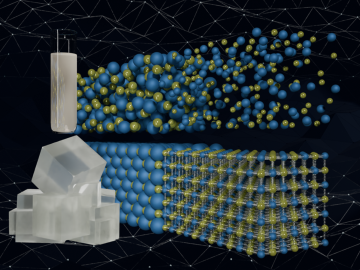
Filter News
Area of Research
- Advanced Manufacturing (1)
- Biology and Environment (23)
- Computational Biology (1)
- Computational Engineering (2)
- Computer Science (6)
- Electricity and Smart Grid (2)
- Energy Science (41)
- Functional Materials for Energy (1)
- Fusion and Fission (11)
- Fusion Energy (9)
- Isotopes (1)
- Materials (26)
- Materials for Computing (4)
- Mathematics (1)
- National Security (4)
- Neutron Science (3)
- Nuclear Science and Technology (6)
- Nuclear Systems Modeling, Simulation and Validation (1)
- Quantum information Science (1)
- Sensors and Controls (1)
- Supercomputing (14)
News Type
News Topics
- (-) Advanced Reactors (18)
- (-) Biotechnology (6)
- (-) Chemical Sciences (31)
- (-) Fusion (19)
- (-) Grid (28)
- (-) Machine Learning (19)
- (-) Polymers (15)
- (-) Summit (11)
- 3-D Printing/Advanced Manufacturing (57)
- Artificial Intelligence (33)
- Big Data (26)
- Bioenergy (26)
- Biology (31)
- Biomedical (18)
- Buildings (31)
- Clean Water (14)
- Composites (16)
- Computer Science (70)
- Coronavirus (15)
- Critical Materials (13)
- Cybersecurity (9)
- Emergency (2)
- Energy Storage (50)
- Environment (67)
- Exascale Computing (11)
- Fossil Energy (1)
- Frontier (10)
- High-Performance Computing (33)
- Hydropower (6)
- Irradiation (3)
- Isotopes (15)
- ITER (5)
- Materials (70)
- Materials Science (54)
- Mathematics (3)
- Mercury (3)
- Microscopy (21)
- Molten Salt (6)
- Nanotechnology (25)
- National Security (13)
- Neutron Science (42)
- Nuclear Energy (36)
- Partnerships (11)
- Physics (11)
- Quantum Computing (9)
- Quantum Science (18)
- Security (4)
- Simulation (16)
- Software (1)
- Space Exploration (11)
- Statistics (1)
- Transportation (52)
Media Contacts

Scientists have developed a new machine learning approach that accurately predicted critical and difficult-to-compute properties of molten salts, materials with diverse nuclear energy applications.

Scientists at ORNL have developed a vacuum-assisted extrusion method that reduces internal porosity by up to 75% in large-scale 3D-printed polymer parts. This new technique addresses the critical issue of porosity in large-scale prints but also paves the way for stronger composites.

Scientists at Oak Ridge National Laboratory and the University of Colorado Boulder used a gene-silencing tool and a large library of molecular guides to understand how photosynthetic bacteria adapt to light and temperature changes. They found that even partial suppression of certain genes yielded big benefits in modifying the stress response of wild microbes.
Vilmos Kertesz, senior staff in the Biosciences Division at ORNL, has received a 2025 Al Yergey Mass Spectrometry Scientist Award from the American Society for Mass Spectrometry. The award recognizes his contributions to the fields of analytical chemistry and mass spectrometry.
Daniel Jacobson, distinguished research scientist in the Biosciences Division at ORNL, has been elected a Fellow of the American Institute for Medical and Biological Engineering, or AIMBE, for his achievements in computational biology.

Researchers at Oak Ridge National Laboratory have developed a new automated testing capability for semiconductor devices, which is newly available to researchers and industry partners in the Grid Research Integration and Deployment Center.

Benjamin Manard, a nuclear analytical chemist at ORNL, has been named the 2025 winner of the Emerging Leader in Atomic Spectroscopy Award from Spectroscopy magazine.

Researchers at Stanford University, the European Center for Medium-Range Weather Forecasts, or ECMWF, and ORNL used the lab’s Summit supercomputer to better understand atmospheric gravity waves, which influence significant weather patterns that are difficult to forecast.

Maximiliano Ferrari, a researcher in the Grid Systems Architecture group at the Department of Energy’s Oak Ridge National Laboratory, has been elevated to prestigious senior membership in the Institute of Electrical and Electronics Engineers.
Seven scientists affiliated with ORNL have been named Battelle Distinguished Inventors in recognition of being granted 14 or more United States patents. Since Battelle began managing ORNL in 2000, 104 ORNL researchers have reached this milestone.


